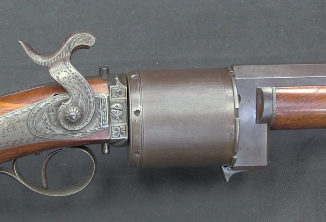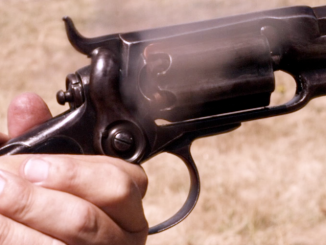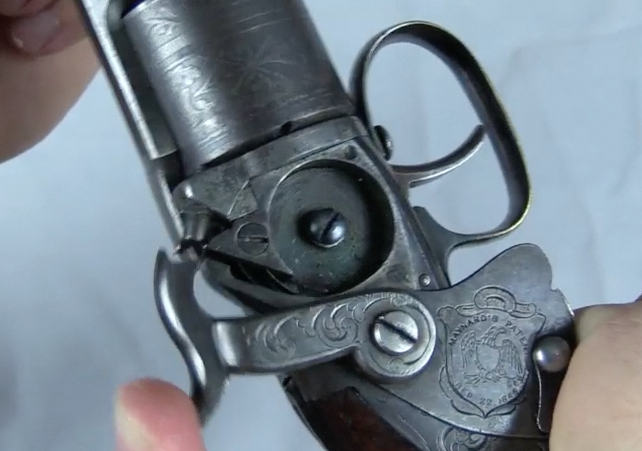As an open-bolt machine gun, the Lewis was not well suited to synchronization on WW1 aircraft – but it was an ideal gun for flexible mounting. To suit this use, a series of aircraft-specific Lewis variations were made. Today, we are looking at a 1918 model made by Savage for the US, chambered in .30-06. It has a single rear spade grip, and no cooling shroud. Instead, a small metal cylinder was added just to protect the gas piston. It has a muzzle brake designed to increase back pressure and raise the rate of fire to 800 or 850 rounds/minute, and was fitted with 97-round double-height pan magazines. The sights are Norman wind vane sights, designed to automatically compensate for the deflection of the gun pointing in different directions relative to the aircraft’s own movement and orientation. By the end of the war, Savage had produced 32,231 aircraft Lewis guns, with this type being the final pattern.
Related Articles

Antiques
Miller Pill-Lock Revolving Rifle
John and James Miller of Rochester New York designed and built this rifle, which is an example of an intermediate revolving firearm. It comes after the flintlock Collier guns, but before Sam Colt’s Paterson demonstrated […]

Antiques
Colt 1855 Revolving Rifle at the Range
I recently had a chance to take a .36 caliber Colt Model 1855 revolving rifle our to the range. It was pretty interesting to shoot, but unfortunately the video ended up rather sub-par and I […]

Revolver
Massachusetts Arms Maynard-Primed Belt Revolver at James D Julia
When the Massachusetts Arms Company initially produced the Wesson & Leavitt Dragoon revolver, they quickly incurred the wrath of the colt company. Those initial revolvers violated several Colt patents. The resulting lawsuit forced the end […]

Here’s a question for you. During both world wars, millions of rounds were fired in aerial combat. Picture the 08th Air Force’s huge raids into Germany. Of course, the vast majority of the rounds missed, yet I’ve never heard of anybody or anything on the ground under the dog fights being hit by falling rounds (or brass, for that matter). I get the impression that farmer’s fields in Kent, England must have been strewn with both – enough for them to routinely dug up….And yet. So what gives. Is it just o case of very big earth and very small (by comparison) bullet.) I know that the Allies went from aluminum to compressed paper drop tanks (carried by fighters to extend their range and pickled away when entering combat) to avoid throwing away the metal and also avoid German salvage, so some fly boys were aware of the Law of Gravity.
https://en.wikipedia.org/wiki/Drop_tank
Thanks !
According to https://www.strategypage.com/htmw/htatrit/articles/20110511.aspx
there were cases property damage from AA guns shells of fragments therefore returning to ground
The British later estimated that some 25 percent of civilian casualties from German World War II bombing attacks on their cities, were from friendly fire. That is, British anti-aircraft shells eventually falling back to earth, causing property damage and casualties.
According to https://www.reddit.com/r/AskHistorians/comments/69d3o1/unintentional_ground_casualties_from_aerial/
Niesje Edelenbos 11 years old, died on the 24th of March 1945 by a stray bullet from a fighter belonging to the Polish 308 Sq. whilst looking for firewood.
Good search Daewoo..
This reminds me of Dylan’s classic: “Hard rain’s gonna fall”
https://www.bobdylan.com/songs/hard-rains-gonna-fall/
Adamant law of cosmic travel dictate that anything will be back to planet if it fail to reach escape velocity, ignoring this might have unpleasant consequences https://paleofuture.com/blog/2014/12/9/that-time-the-canadian-navy-accidentally-bombed-an-american-town
That was returned more than plenty by accidental U.S. Airforce night attack on Canadian troops in Afghanistan in April of 2002
https://en.wikipedia.org/wiki/Tarnak_Farm_incident
It resulted in 4 soldiers killed and 8 injured. Soldiers conducted night training while pilot mistook them as attacking Taliban.
During a field exercise in Northern Germany in the 1960’s in a forest area, I came across a 0.5″ brass cartridge case in very good condition, from memory the head stamp was “FA 42”. On another occasion we dug up the remains of a leather bandoleer containing a number of clips containing steel cased 7.92 x 57 ammunition, the cases were badly corroded and the head stamps were illegible. However when broken open the powder could be ignited by a flame. We didn’t have long and a search hoping to find the rifle to go with it failed.
“(…)Northern Germany in the 1960’s in a forest area(…)”
Well, where there was intensive fighting artifacts might be unearthed years later, take for example ZONE ROUGE https://en.wikipedia.org/wiki/Zone_Rouge
it was so full of shells and chemical agents that agricultural actives were prohibited as too dangerous and in effect it was abandoned.
A few months ago (less than a year), a resident of the east coast of England brought in for identification a bullet found in the roof of his old house during renovations.
It was a 30-06 manufactured in England for Lend-Lease machine guns.
“Everything that took off must land.”
My grandfather said that they did not have to be forced to wear helmets during anti-aircraft fire. Because after the ceasefire, there was a rustle in the air for a couple of minutes from the falling remains of their own shells.
In Barrow-in-Furness in the early 1940’s on my way to school after an air raid the previous night, there were often lumps of metal lying around in the streets. We would collect them and take them to school to show to friends, no one bothered. With hindsight these were parts of exploded anti-aircraft shells and not pieces of German bombs as we thought at the time.
First my compliments on an (as usual) excellent piece – I struggling to find much on the air Lewis specializations – which an exemplary exercise in ingenuity. Notably the magazine (does anyone have a weight for the air type – ideally empty and filled?). I note that contemporary British sources found the Savage guns rather roughly manufactured (though still fully functional). Any opinions on this?
Stupid question: How hard would it be to yank the observer’s Lewis gun off the ring mount and fire it from the hip if the plane force-landed in hostile territory?
Use of board mounted MG in enemy held territory might end up for crew as a fatality instead of being taken POWs.
Oh yes, in Biggles’ adventures I read of shenanigans of this kind, but they were far fetched from reality.
https://www.amazon.com/Biggles-Big-Adventures-Captain-Johns/dp/1853756164
Nevertheless, such an opportunity was envisaged.
https://www.ima-usa.com/products/original-british-wwi-lewis-aircraft-gun-modified-for-wwii-home-guard-with-97-round-drum-magazine?variant=26170428165
Those modified Savage-made Lewis guns saw actual combat on British merchant vessels. During the first year of the Second War, they were the “coasters'” only defense against attacks by the Luftwaffe, notably Ju88s and Ju87s, both of which tended to bomb and strafe at mast-top level (under 100 feet).
The Savage-Lewis guns were in such short supply compared to the numbers actually needed that they were “bicycled” back-and-forth between ships on a daily basis. That is, a coaster coming in to dock would hand its guns over to one about to leave port.
The irony is that it was mostly a morale “thing”. The cargoes carried up and down the Channel coast could more simply have been delivered by railroad and lorry, where for the most part the Luftwaffe would have had no chance to get at them. But the British Admiralty was determined to show the world that it still controlled the English Channel- no matter what the cost to the merchant seamen who were the instruments of its “PR campaign”.
See The Secret War aka Wheezers and Dodgers by Gerald Pawle (RNVR).
cheers
eon
“(…)could(…)have been delivered by railroad(…), where for the most part the Luftwaffe would have had no chance to get at them(…)”
What prevented Luftwaffe from strafing trains or bombing rails?
Range. The railways mostly ran up the flatter areas of the South of England, inland of London.
Operating from bases in France and the Low Countries, bombers attacking London only had roughly half-an-hour loiter time over the target area before they had to RtB or risk running out of fuel over the Channel, or worse the North Sea.
Fighters such as Bf-109Es escorting bombers during the battle of Britain had a maximum of ten minutes in the London target area for the same reason. And that was from bases in the Pas de Calais, to boot.
Trying to reach the “trunk” of the rail lines with Ju88s or even He111s would have virtually guaranteed the loss of a huge percentage of aircraft and crews due to fuel exhaustion on the return leg. The shorter-ranged Ju87 couldn’t have gotten back over the English coast before it was out of fuel.
The USAAF experienced the same thing for real in 1944-45 attacking the Japanese home islands with B-29s from Pacific island bases.
Due to the Wright R-3350 Duplex Cyclone engines never delivering the HP they were designed to, the Superforts took over 20 minutes to reach cruise altitude with a full bomb and fuel load, and to maintain a cruise speed of 220 knots had to be flown at 80% throttle instead of the standard 60%. Add in winds aloft, and of 4500 B-29s in service, of the 2200 lost in combat over three-fourths fell victim to fuel exhaustion enroute back to base rather than enemy action.
The follow on B-50 (originally the B-29D) was powered by the Pratt & Whitney R-4360 Wasp Major turbo-compound radial. It could easily get to 20,000 feet in four minutes with a full load and cruise at 250 knots at 55% throttle simply because the Wasp Major was a lot more powerful than the Duplex Cyclone and thus had more HP to spare.
As to why the Wasp Major wasn’t available during the war, the entire production was earmarked for the Consolidated (later Convair) B-36, which was supposed to enter service in mid-1944.
Consolidated kept saying “Any day now!” and Washington kept believing them. The B-36 finally entered squadron service in 1947. Just in time to be rendered obsolete by the Boeing B-47 and B-52 jet bombers.
Moral; Enemy fire may kill you. Fuel exhaustion absolutely will kill you.
So watch your throttle settings.
cheers
eon
Promises by people who have (or who are trying to get) big handouts of tax victims hard earned…
And over priced, under performing and late aircraft and aircraft engines
From the total failure of the WWi ABC Dragon fly engine
To today’s F35
Trains
http://www.bbrclub.org/Defence%20of%20Trains%20by%20Barrage%20Balloons.htm
The B-47 entered full service in 1953 and the B-52 in 1955, so the B-36 had several years as the main USAF strategic bomber. The B-47 also didn’t have the unrefuelled range to attack targets in Soviet Union from bases in the US mainland, and therefore it couldn’t completely replace the B-36.
Aircraft development in the early jet age was so fast that about 5 years as the primary combat aircraft of any type was a reasonably long career, and especially so for a piston engined aircraft.
In the 1960’s I served with a person who had been on UK airfield defense in the early 1940’s, he told me that their Lewis guns were preferred to the Brens as he put it “using tracer they could hose onto the enemy before the magazine emptied”.
Wasn’t there a drum available for the BREN?
“…drum available for the BREN…”()
I think the fact is that most of the BRENs (almost all the ones in the army at that time) were lost in Dunkirk.
Along with additional equipment such as scopes, tripods and magazines for AA shooting.
Naturally, all newly produced weapons were sent to the armament of the restored units.
And the merchants…
the king has a lot.
A friend who is in a very rural part of the vale of York, still has a farmyard gate that took a bullet from a German aeroplane, that was firing at a train on the nearby and very little used railway line.
Attacks on rail transport, did take place, though I’m not sure about the frequency.
Friend is curious about what the German was playing at, attacking a train in an area that was home to lots of big military airfields, some of which (Dishforth, Leeming, Lynton on Ouse…) are still active
Lewis Gun Mark III DEMS – Intended for Defensively Equipped Merchant Ships
https://i.redd.it/i514qcv487t61.png
I just cannot resist a comment, particularly valid in the era of remote teaching: Ian is an excellent lecturer! I think it is not only a skill but also a talent. If you think it is just ‘talking to the camera’ – try it yourself.
I once read that T.E Lawrence (ie of Arabia) said that he carried an air Lewis gun in a leather saddle ‘holster’ on his camel during some of his campaigns in the desert in WW1.
I’m having a moment here with this front sight. Well, “crisis” might be the more accurate word.
I cannot for the life of me figure out how that front sight is supposed to work. Everything in my mind says that the front sight post is moving the opposite direction that it should to accommodate changes in wind.
This is because Ian did not quite correctly put it.
This meant anticipating the movement of the shooting position.
I had the same problem, until the diagrams in this forum thread (https://forum.axishistory.com/viewtopic.php?t=17649) made it click for me.
The idea of the sight is not to counteract the effect of the wind/airspeed on the bullet, but to “cancel” the bullet’s forward momentum (from the forward movement of the shooting airplane) by shooting to the rear. That way, each shot can be calculated as if you were static.
Side effects include:
– It’s way easier to shoot at a static target from the moving plane;
– If you use it from a static position in a lot of wind, it compensate the wrong way.
The Japanese used copies of the Lewis Gun in WWII.